Bone Markings
Objective 9.7
9.7.1 Define condyle, epicondyle, facet, fissure, foramen, fossa, head, meatus, process, spine, sulcus, trochanter, trochlea, tubercle, and tuberosity.
Several descriptive terms crop up over and over when we’re naming bumps and grooves and markings on bones. Several are listed here. You will not need to know specific examples of these markings; rather, you should know what each of the listed descriptive terms means. For example, be able to define and identify a condyle, but don’t worry about lateral condyle vs medial condyle.
Condyle means knuckle (for example, the lateral condyle and medial condyle of the tibia). Condyles are rounded and articular (covered with hyaline cartilage, make up an articular surface in a joint).
Epicondyles are upon or next to condyles, such as the lateral epicondyle and medial epicondyle of the femur at the knee joint. Epicondyles are rough, non-articular (not covered with hyaline cartilage), and serve as attachment points for tendons and/or ligaments.
Fossa means trench or ditch and describes a shallow depression/groove.
A trochanter or runner is a very large projection. The femur has a greater (larger) trochanter and a lesser (smaller) trochanter. Trochanters are rough, non-articular attachment points.
Foramen (plural foramina) means window. Most bones have a nutrient foramen where the nutrient artery enters the bone. As we shall see, the bones of the skull have numerous foramina which allow passage of vessels and nerves. The largest of these, the foramen magnum, is where the spinal cord exits the skull and enters the vertebral canal.
A tuberosity is a rough, variable sized bump, such as the tibial tuberosity, radial tuberosity, or ischial tuberosity. Tuberosities are rough, non-articular attachment points.
A process is a projection, such as the xiphoid process of the sternum (Greek ξιφιδιον, like a dagger). There is also a styloid process of the radius and ulna and a styloid process of the temporal bone (Greek στυλος or Latin stylus, like a pen). The ulna has a crown-like coronoid process; the temporal bone has a nipple-like mastoid process; and vertebrae have spinous, transverse, inferior articular, and superior articular processes. Processes are rough, non-articular attachment points.
A trochlea is a pulley, a specific type of smooth, articular groove. We have one in the elbow, one in the ankle, and one in the eye socket.
A facet is a smooth, slightly convex or concave articular surface. Each vertebra has a number of facets to articulate with its neighbor vertebrae and (in the case of the thoracic vertebrae) ribs.
A head is a rounded articular projection at the end of a neck of bone. The humerus has a head, as do both the radius and femur.
A spine is a pointy process, like the spinous process of a vertebra or the ischial spine of the pelvis. Spines are rough, non-articular attachment points.
Tubercle means potato-like bump, such as the greater tubercle and lesser tubercle of the humerus at the shoulder joint. Tubercles are rough, non-articular attachment points.
A narrow slit in a bone is a fissure.
A meatus is a tube-like opening. A great example is the external auditory meatus of the temporal bone, the bony tube inside of which we find the ear canal.
A sulcus (plural sulci) is a shallow depression. Sulci accommodate nerves, blood vessels, or tendons.
Examples of bone markings:
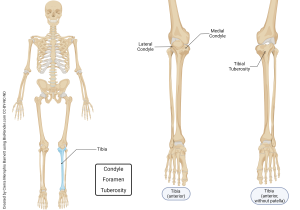
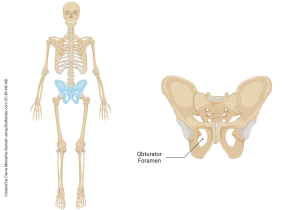
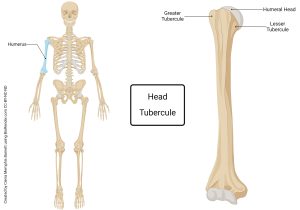
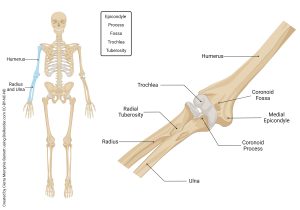
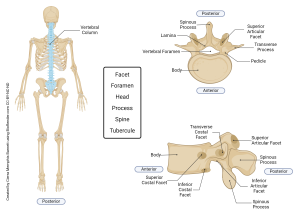
Media Attributions
- U09-038 U09-039 Tibial Bone Markings © Barnett, Cierra Memphis is licensed under a CC BY-NC-ND (Attribution NonCommercial NoDerivatives) license
- U09-036 U09-037 Pelvic Bone Markings © Barnett, Cierra Memphis is licensed under a CC BY-NC-ND (Attribution NonCommercial NoDerivatives) license
- U09-042 U09-043 Humerus Bone Markings © Barnett, Cierra Memphis is licensed under a CC BY-NC-ND (Attribution NonCommercial NoDerivatives) license
- U09-040 U09-041 Bone Markings on Humerus, Radius, and Ulna © Barnett, Cierra Memphis is licensed under a CC BY-NC-ND (Attribution NonCommercial NoDerivatives) license
- U09-044 U09-045 U09-046 Vertebrae Bone Markings © Barnett, Cierra Memphis is licensed under a CC BY-NC-ND (Attribution NonCommercial NoDerivatives) license

